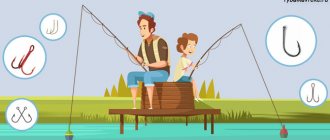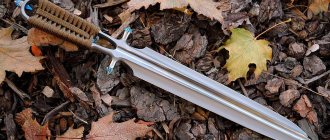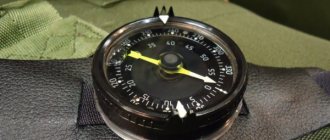Methods for placing a worm on a hook
- One worm at intervals . The bait is pierced at a distance of 1-1.5 cm in 2-3 places with a hook, the point is hidden inside the worm. They catch silver bream, roach, ram, carp, perch, etc.;
- One worm in a ring. The worm is placed on the hook with two punctures in the area of the head and tail. Prevents small fish from constantly tugging at the bait. Designed for catching large fish in places where there are a lot of small fish. Used when fishing with a durable worm;
- One worm is pierced behind the head or in the middle of the body. Used for fishing when there is a confident bite. Used when fishing with a durable worm;
- One whole worm. Half to two thirds of the worm is threaded onto the hook. To avoid the fish pulling the bait, move the tip of the hook tip slightly outward. Restricts the movement of the bait and severely damages the worm. Suitable for catching small fish;
- Several worms (garland) . 2-3 worms are baited at intervals on one hook. Suitable for catching large fish.
- Several small worms on one hook. For catching large fish;
- 2-3-5 worms are baited by the head part. The bait remains mobile for a long time. Suitable for catching large fish in places where small fish are not annoying.
- A piece (half) of a worm on one hook. Used for catching small fish on small hooks;
- Sandwich . After the worm, a grain of cereal or corn is placed on the hook. Along with the worm, a maggot is placed on the hook. In addition to the fact that the maggot actively moves, it also prevents the fish from pulling the worm off the hook;
- A tackle of 2-3 hooks tied on a leash at a distance of 2-3 cm. One worm on such a tackle is sequentially placed on the hooks, starting from the top one. The worm on the rig remains mobile and behaves naturally. Used for setting large bait when catching trophy specimens.
How to put a worm on a hook depending on the type of fish
The effectiveness of a bait such as a worm can be maximum, or it can drop to zero. The fact is that different types of fish react differently to bait. It is important to know how to properly attach a worm so that the fish wants to eat it.
Worm for crucian carp
Crucian carp will like dung or earthworm. It is important that its tip wriggles in the water, then large fish will be attracted. A bunch of small and medium-sized individuals is suitable. Small fish will bite on the pieces. There are several ways to put a worm on a crucian carp:
- over the head with a long tail left;
- by the tip. The worm should not exceed 1 cm. You can use part of it;
- through the entire body by threading it in several places.
You can soak the worm in mint or grass before fishing.
How to put a worm on a hook for bream
Bundles of worms are suitable for bream. Crawls are suitable for night fishing. Their body is pierced at the beginning and in the middle. You can use pieces by planting them in a chaotic manner. To prevent the bream from falling off, the worm is pierced lengthwise, going onto the fishing line. The tackle will increase the chances of a good catch. With any method, the sting should not look out.
How to attach a worm for carp
Regular earthworms will do. The bait is pierced in the head area, going down slightly. Several punctures are made, and the sting is hidden in the remainder of the tail. When fishing with a feeder or donk, a “sandwich” of bait is used. Before casting, the carp are fed dough or maggots. In addition to corn, a hair rig attached to the end can be attached to the mounted worm.
What worms can be used for fishing
Worms are distinguished by color, size and habitat. For fishing purposes the following are most often used:
- Dung worm . Sometimes the worm is called maggot. Characteristic pungent odor, strong, often mottled skin. Excellent hold on the hook. There are two types of dung worms. Brick red worm - large size, can be divided into parts. Used for catching large specimens of crucian carp, carp, tench, silver bream, etc. The red-yellow worm is small. This worm is used to catch small fish - gudgeon, ruffe, roach, etc.;
- Crawling out . The second name of this worm is large earthworm. Large, up to 30 cm long and up to 1 cm thick, worm. Lives in deep layers of soil. Prefers fertilized soils. It crawls completely or partially to the surface at night. Suitable for catching large fish;
- Earthworm . Length 5-15 centimeters. Pale pink or gray color. Stays firmly on the hook. Used for bottom fishing, especially at night, for example burbot. Not very popular among fishermen;
- Green worm . Gray or dark green color;
- Zheleznyak . Gray-smoky color. Length up to 15 cm. Lives in clayey soil. Stays great on the hook. Used to catch predators;
- Subleaf . Red-blue or purple color. Delicate, easy to tear. It can be larger in size than an earthworm and a dungworm. Not afraid of the cold. Requires secure fastening to the hook. Use a barbed hook or pierce the worm with a thin hook several times;
- Water underleaf . Almost transparent. Used for fishing silver bream, perch, roach, rudd. A common food item for fish;
- Water worm . Brown-red or pale red color. Rough. Length up to 20 cm, thickness up to 0.5 cm. Easily torn. Large hooks required.
Choosing the right hooks
Worms are quite bulky and heavy bait. Based on this, you need to select hooks that are correct in size and shape. There is no way to properly attach a worm to a small hook; therefore, an incorrect and rough bait will alarm the potential catch and prevent it from effectively biting. In most methods, placing a worm on a hook involves the length of the entire shank, and since the worm is long in its physiology and structure, the shank of the hook must be elongated for convenience.
The thickness of the hook should be judged based on the type of fish planned to be caught. If you focus on catching catfish, then hooks for crawling bait are used from thick wire and with a sting bent inward. The bending of the tip prevents the worm from spontaneously coming off the hook when it is attached in a bunch. For bream, more elegant and thinner hooks are used. Subleaf and dung worms are more delicate and require more care when baiting. Earthworms and earthworms are not afraid of being punctured by thick hooks, but for swamp worms they use hooks made of the thinnest wire with a rather sharp sting.
Important! The color of the hook is selected in dark colors. Black, blue and dark gray species are recommended by experts when fishing with worms.
If you plan to attach the worm to the fishing line, then you should pay attention to the fastening element of the hook. In this case, you need to choose hooks with a blade, and not with an eye or a ring. Hooks with a spatula will injure the worm to a lesser extent, leaving it in a mobile state longer, and the knot with which these types of hooks are tied will not cause difficulties when pulling the worm onto the fishing line.
Where to dig for worms
- Dung worms live in rotted manure, in various organic waste dumps, in the soil of barnyards, and in compost heaps. Dig with a pitchfork or rake. This way the bait is less damaged. Most often found in colonies. In places where there is no fishing press, obtaining this worm does not take much labor or time. Doesn't like heat;
- In the warm season, crawling is collected in parks and gardens at night with the help of a flashlight. The worm is also collected in the early morning, after dew has fallen, on park, garden paths and paths. When collecting bait at night, try not to point the direct light of the flashlight directly at the worm. Direct light, noise and stomping forces the worm to hide in a hole. It only takes half a second for a worm to hide in its house. It rarely crawls out of the hole completely, therefore, having caught the worm by the upper part, closer to the hole, it is gradually pulled out of the ground. Sometimes worms crawl out of their holes during drizzling rain. The crawling habitats can be easily determined during the day by the presence of characteristic holes in the ground;
- Earthworms are collected in beds or, after rain, on paths. The rain floods the burrows, and the worms are forced to leave them, crawling to the surface. Dig the worm using a fork or shovel in the same places where it appears after rain. Worms live in almost any meadow. If there is no shovel or pitchfork, the bait is found by tearing the turf from the ground;
- The green worm is caught in the rich soil of coastal meadows or under swamp hummocks;
- Ironweed lives in clayey soil. Here they dig it with a shovel;
- The underleaf lives under compacted layers of fallen leaves, under dense layers of pine broom, under sawdust or under compacted old straw. To determine the most likely habitat of the worm, lowlands, holes, and small funnels that retain moisture are found;
- Water underleaf is collected from the underside of water lilies;
- The waterworm is found in muddy areas of rivers, near piers, timber rafts and rafts. For mining, a shovel is used, with which the bottom soil is scooped onto the shore.
Tips for storing bait
Now we will try to give some useful tips on storing bait and more, which will keep the worms fresh and attractive to fish for as long as possible.
- You should always take a small shovel when fishing. Its presence will allow you to dig up worms right next to the reservoir, which will be even tastier for crucian carp than those previously purchased in the store or brought.
- A box of worms should not be stored in the sun. It should definitely be placed in the shade. For example, you can put it under a bush. Otherwise, if they lie in direct sunlight for a couple of hours, they will simply become unsuitable for planting.
- To ensure that the worms on the hook are as mobile as possible, you should dip them in garlic juice before throwing them into the pond. As an alternative, you can use sunflower or hemp oil. This will definitely cause them to move extremely actively.
- Also, to improve the bite, you can add a couple of drops of flavoring to the container where the worms are located, which has a natural smell. For example, you can use strawberries, cottage cheese and crushed cherries. They will definitely add a bright aroma and attract prey.
- When catching smaller fish, you don't have to leave the worm tails on the hook. Such a fish usually immediately swallows the bait, which is why you can simply cover the tip with a small piece of a centimeter and a half.
- The storage container must be equipped with a lid with holes through which fresh air will flow in. This will keep the food attractive to the fish.
- The container lid should be closed tightly to prevent worms from crawling out.
- Before collecting the worms, you should add a little soil to the container so that the fish thinks that the worm is completely fresh.
- It is not recommended to store bait in containers made of tin, as a result it may acquire a specific odor and its attractiveness to prey will be significantly reduced.
- If you have several types of bait, it is better to separate them from each other and store them in different containers.
- When storing bait in a container with soil, you can add a couple of tea drops daily for freshness.
- The soil for bait should be taken exclusively from the same place where it was dug, so that it remains fresh for as long as possible.
As you can see, there are a large number of ways to properly attach worms to hooks. And when a fisherman masters all the intricacies and features of various techniques, he will be able to make his fishing not just something that will bring pleasure, but also the most effective.
How to put a worm on a hook, see the video below.
Recommendations for choosing a rigging method when fishing for different types of fish
Each type of fish has its own specific feeding habits. Some species feed only at the bottom, others only at the surface, and others combine both. Fish also differ in the rate at which they consume the food they find. Some species immediately grab everything that moves, others repeatedly try, tug and only then swallow. Most often, the worm is used to catch fish from the bottom. Based on this specificity, fishermen have developed the most successful recommendations for catching various types of fish;
- For crucian carp. They use types of worm bait in which a long, moving tail or tails remain, except in cases where there are a lot of small crucian carp in the reservoir. For catching large and medium-sized crucian carp, a bunch of several small or medium-sized worms is suitable. For catching small crucian carp - pieces of a worm or its small specimens with the obligatory removal of the hook point outward. In some reservoirs, crucian carp prefers a worm that has already been chewed by previous bites. In this case, after baiting the hook, the tip of the worm is crushed;
- For bream. You can use “crucian carp” bait methods. Does not like bait that is too bulky. I really like bait made from several pieces of worm or a bunch of small worms. It can be useful, when baiting a worm with a “stocking,” to move it above the hook onto the fishing line. To catch large specimens, a medium-sized crawler with a tail hanging from a hook is used. In all methods, the sting of the hook is hidden inside the worm;
- For carp . Most often, a dung worm is used in the form of a garland of several worms. It is very good for catching carp to use a sandwich made of a worm, pierced at intervals and with a grain of corn. Baiting a hair rig with a worm pierced in two or three places has proven to work well. Used for catching carp and a bunch of small worms pierced with a hook in the middle. It happens that it bites well on earthworms collected near a pond;
- For catfish . The largest of the worms, the crawler, is used. 3-6 worms are placed on the hook. The catfish's mouth is huge and is capable of swallowing everything that is offered to it. To attach worms when catching catfish, in addition to a single hook, a double hook is used. It is useful to secure the worm on the hook with a stopper of animal or plant origin - maggot, live bait, leech, frog, locust, mole cricket, corn, pearl barley, clam.
Classical technique
A beginner needs to remember the rules:
- the sizes of tackle and bait must be correctly selected;
- The worm should be baited in such a way that it remains active and moves, otherwise the fish will not notice it.
When catching large fish, you can attach several worms at once, this will increase the chances. If the fish is small, you can use parts of the bait, but this reduces the mobility of the bait and the likelihood of a successful catch.
Placing a worm on a hook correctly is not an easy task. The classic way is with stockings.
Attaching a worm to a hook with a stocking
The bait is pulled onto the tackle like a stocking. It is necessary to pierce the hook needle and pull the bait to the base. The remaining tail can be left free or cut off.
Another option is to hook with a “stocking” - the first puncture is made not from the very edge, but stepping back a little, then the free tail will remain at the base of the hook.
This is interesting: How to put maggots on a hook
Tips and fishing secrets
- experiment with different types of worms;
- Don't get hung up on one type of worm because it's "available at your local store";
- Keep in mind that matching the size and type of fish, bait and hook is the key to successful fishing;
- the long tip of the worm can tempt large fish, but attracts small ones;
- even if there are no bites, change the worm every half hour;
- the stock of worms should not limit the angler’s ability to change bait;
- the worm should not burrow into the soil at the bottom of the reservoir;
- the worm is dipped in hemp, sunflower oil or garlic extract. The oil will give the bait a pleasant smell, garlic, in addition to the smell, will add activity;
- the dung worm does not need additional smell.
The worm is undoubtedly the most popular and affordable bait for any angler, be it a city dweller or a rural resident. There are a lot of options for putting a worm on a hook. Hooks with barbs were invented especially for this bait. Worms are used for fishing on almost all types of fishing gear. The effectiveness of the worm does not lose its significance even in winter. Almost no angler goes fishing without this bait.
Where to look for worms near a pond
It may happen that an amateur fisherman can come to a pond without bait, that is, without a worm. After all, it happens that hunters forget their gun, and this can happen to a fisherman. In this case, you can look for the worm directly near the pond, all you need is a shovel. If you still have a shovel at home, you can try to find it in shallow water using your hands. You can find out how this is done by watching the video. In any case, the river worm is no worse than the red dung worm.
Many fishermen claim that purchased worms are more attractive to fish than those obtained from the ground on their own. This may be true, but red dung worms are very difficult to replace with earthworms. Dung worms are more active and therefore attract fish better. And here a lot depends on how carefully the fisherman placed the worm on the hook.
What should be the hook for crucian carp?
Dimensions
Let's start with the hook sizes. Let's determine what size is needed for small-medium-sized crucian carp and what size is needed for trophy specimens. First, let's decide on the numbering of hook sizes. The classification of hook sizes is divided into domestic, international, Finnish and Japanese . These are the 4 main classifications by which you will be guided.
| International sizes | Domestic (in mm) | Finnish | Japanese |
| 24 | — | — | 26 |
| 22 | — | — | 24 |
| 20 | — | — | 22 |
| 19 | 2 | 22 | 21 |
| 18 | 2,5 | 20 | 20 |
| 17 | 3 | 18 | 19 |
| 16 | — | — | 18 |
| 15 | 3,5 | 16 | 17 |
| 14 | — | — | 16 |
| 13 | 4 | 14 | 15 |
| 12 | — | — | 14 |
| 11 | 4,5 | — | 13 |
| 10 | 5 | 12 | 12 |
| 9 | — | — | 11 |
| 8 | 6 | 10 | 10 |
| 7 | — | — | 9 |
| 6 | 7 | 8 | 8 |
| 5 | 7,5 | — | 7 |
| 4 | 8 | 6 | 6 |
| 3 | 8,5 | — | 5 |
| 2 | 9 | 4 | 4 |
| — | 11 | 1 | — |
| — | 12 | 1/0 | — |
| — | 14 | 2/0 | — |
| — | 16 | 3/0 | — |
Sizes of hooks for catching crucian carp.
| Classification | Minimum size | Maximum size |
| International | 13 | 5 |
| Domestic | 3 (mm) | 7.5 (mm) |
| Finnish | 18 | 6-8 |
| Japanese | 19 | 7 |
As you can see, according to the domestic classification, crucian carp are caught on hooks numbered from No. 3 to No. 7.5. For medium-sized crucian carp, the optimal hooks are numbers No. 5, No. 6.
Shape (forend and tip)
When catching crucian carp with a worm, it is worth taking hooks with a slightly curved shank so that when the worm is fully inserted, it retains its flexibility and is not straight. A direct worm is suspicious.
For spring crucian fishing , when vegetable baits and cereals are used, the shape of the forend does not matter. It also doesn’t matter what shape the hook is if you are making a sandwich from bait (most often used in the fall) - for example, a worm between two corn or peas or pearl barley (and other cereals). Curved hooks work well both for fishing with a float rod and with a feeder.
For catching crucian carp with maggots, the shape of the forend does not matter at all.
An important aspect of the shape is where the sting faces. It is good if it is curved so much that it looks towards the fore-end. This directly affects the chance that the crucian carp will catch on the hook and firmly attach to it, eliminating the possibility of failure
.
Color and material
The key to the durability and constant sharpness of the hook is the material of the hook . The packaging should indicate that the hook is made of steel thread .
in color , the main thing is that the hook is not colorful. However, such hooks are rare. Light silver color is classic when fishing for crucian carp.
The classic method of putting on “Stockings”
With this method, the worm is placed on a hook like a stocking on a leg, hence the name of the method. This method has several variations, but the principle is always the same. You stretch the worm from the sting all the way to the eye of the hook along its body.
The tail that remains hanging can be torn off or left. You can start piercing the worm either from the very end or by stepping back a little, leaving a small tail hanging down. You can also slightly release the hook tip from the bait, this increases the likelihood of the fish hooking itself when biting.
The options shown above are sufficient for most fishing situations. But sometimes, in order to somehow provoke the fish to bite, you have to look for various tricks and methods of baiting in order to finally see the long-awaited bite. Let's look at a few more options.











